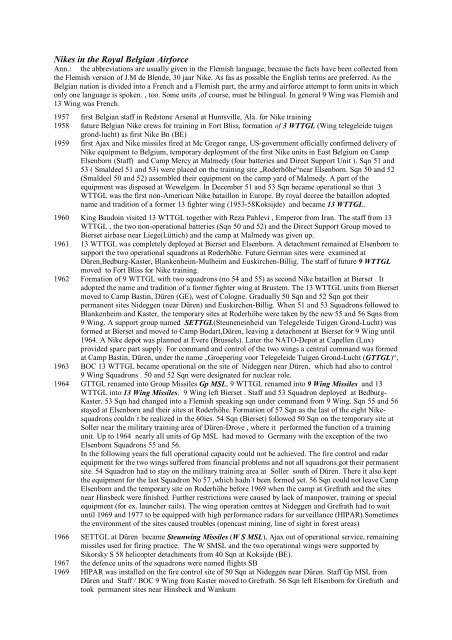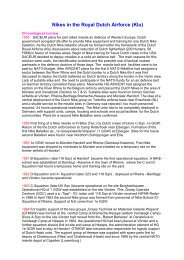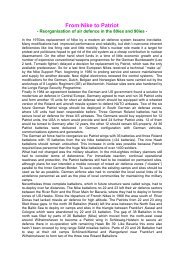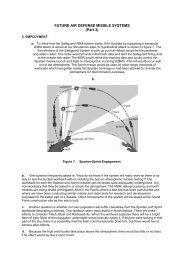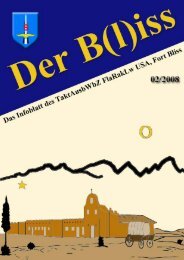Nikes in the Royal Belgian Airforce - Rolfs NIKE Pages
Nikes in the Royal Belgian Airforce - Rolfs NIKE Pages
Nikes in the Royal Belgian Airforce - Rolfs NIKE Pages
Create successful ePaper yourself
Turn your PDF publications into a flip-book with our unique Google optimized e-Paper software.
<strong>Nikes</strong> <strong>in</strong> <strong>the</strong> <strong>Royal</strong> <strong>Belgian</strong> <strong>Airforce</strong><br />
Ann.: <strong>the</strong> abbreviations are usually given <strong>in</strong> <strong>the</strong> Flemish language, because <strong>the</strong> facts have been collected from<br />
<strong>the</strong> Flemish version of J.M de Blende, 30 jaar Nike. As fas as possible <strong>the</strong> English terms are preferred. As <strong>the</strong><br />
<strong>Belgian</strong> nation is divided <strong>in</strong>to a French and a Flemish part, <strong>the</strong> army and airforce attempt to form units <strong>in</strong> which<br />
only one language is spoken. , too. Some units ,of course, must be bil<strong>in</strong>gual. In general 9 W<strong>in</strong>g was Flemish and<br />
13 W<strong>in</strong>g was French.<br />
1957 first <strong>Belgian</strong> staff <strong>in</strong> Redstone Arsenal at Huntsville, Ala. for Nike tra<strong>in</strong><strong>in</strong>g<br />
1958 future <strong>Belgian</strong> Nike crews for tra<strong>in</strong><strong>in</strong>g <strong>in</strong> Fort Bliss, formation of 3 WTTGL (W<strong>in</strong>g telegeleide tuigen<br />
grond-lucht) as first Nike Bn (BE)<br />
1959 first Ajax and Nike missiles fired at Mc Gregor range, US-government officially confirmed delivery of<br />
Nike equipment to Belgium, temporary deployment of <strong>the</strong> first Nike units <strong>in</strong> East Belgium on Camp<br />
Elsenborn (Staff) and Camp Mercy at Malmedy (four batteries and Direct Support Unit ). Sqn 51 and<br />
53 ( Smaldeel 51 and 53) were placed on <strong>the</strong> tra<strong>in</strong><strong>in</strong>g site „Roderhöhe“near Elsenborn. Sqn 50 and 52<br />
(Smaldeel 50 and 52) assembled <strong>the</strong>ir equipment on <strong>the</strong> camp yard of Malmedy. A part of <strong>the</strong><br />
equipment was disposed at Wewelgem. In December 51 and 53 Sqn became operational so that 3<br />
WTTGL was <strong>the</strong> first non-American Nike bataillon <strong>in</strong> Europe. By royal decree <strong>the</strong> bataillon adopted<br />
name and tradition of a former 13 fighter w<strong>in</strong>g (1953-58Koksijde) and became 13 WTTGL.<br />
1960 K<strong>in</strong>g Baudo<strong>in</strong> visited 13 WTTGL toge<strong>the</strong>r with Reza Pahlevi , Emperor from Iran. The staff from 13<br />
WTTGL , <strong>the</strong> two non-operational batteries (Sqn 50 and 52) and <strong>the</strong> Direct Support Group moved to<br />
Bierset airbase near Liege(Lüttich) and <strong>the</strong> camp at Malmedy was given up.<br />
1961 13 WTTGL was completely deployed at Bierset and Elsenborn. A detachment rema<strong>in</strong>ed at Elsenborn to<br />
support <strong>the</strong> two operational squadrons at Roderhöhe. Future German sites were exam<strong>in</strong>ed at<br />
Düren,Bedburg-Kaster, Blankenheim-Mulheim and Euskirchen-Billig. The staff of future 9 WTTGL<br />
moved to Fort Bliss for Nike tra<strong>in</strong><strong>in</strong>g.<br />
1962 Formation of 9 WTTGL with two squadrons (no 54 and 55) as second Nike bataillon at Bierset . It<br />
adopted <strong>the</strong> name and tradition of a former fighter w<strong>in</strong>g at Brustem. The 13 WTTGL units from Bierset<br />
moved to Camp Bast<strong>in</strong>, Düren (GE), west of Cologne. Gradually 50 Sqn and 52 Sqn got <strong>the</strong>ir<br />
permanent sites Nideggen (near Düren) and Euskirchen-Billig. When 51 and 53 Squadrons followed to<br />
Blankenheim and Kaster, <strong>the</strong> temporary sites at Roderhöhe were taken by <strong>the</strong> new 55 and 56 Sqns from<br />
9 W<strong>in</strong>g. A support group named SETTGL(Steunene<strong>in</strong>heid van Telegeleide Tuigen Grond-Lucht) was<br />
formed at Bierset and moved to Camp Bodart,Düren, leav<strong>in</strong>g a detachment at Bierset for 9 W<strong>in</strong>g until<br />
1964. A Nike depot was planned at Evere (Brussels). Later <strong>the</strong> NATO-Depot at Capellen (Lux)<br />
provided spare part supply. For command and control of <strong>the</strong> two w<strong>in</strong>gs a central command was formed<br />
at Camp Bast<strong>in</strong>, Düren, under <strong>the</strong> name „Groeper<strong>in</strong>g voor Telegeleide Tuigen Grond-Lucht (GTTGL)“,<br />
1963 BOC 13 WTTGL became operational on <strong>the</strong> site of Nideggen near Düren, which had also to control<br />
9 W<strong>in</strong>g Squadrons . 50 and 52 Sqn were designated for nuclear role.<br />
1964 GTTGL renamed <strong>in</strong>to Group Missiles Gp MSL, 9 WTTGL renamed <strong>in</strong>to 9 W<strong>in</strong>g Missiles and 13<br />
WTTGL <strong>in</strong>to 13 W<strong>in</strong>g Missiles. 9 W<strong>in</strong>g left Bierset . Staff and 53 Squadron deployed at Bedburg-<br />
Kaster. 53 Sqn had changed <strong>in</strong>to a Flemish speak<strong>in</strong>g sqn under command from 9 W<strong>in</strong>g. Sqn 55 and 56<br />
stayed at Elsenborn and <strong>the</strong>ir sites at Roderhöhe. Formation of 57 Sqn as <strong>the</strong> last of <strong>the</strong> eight <strong>Nikes</strong>quadrons<br />
couldn´t be realized <strong>in</strong> <strong>the</strong> 60ies. 54 Sqn (Bierset) followed 50 Sqn on <strong>the</strong> temporary site at<br />
Soller near <strong>the</strong> military tra<strong>in</strong><strong>in</strong>g area of Düren-Drove , where it performed <strong>the</strong> function of a tra<strong>in</strong><strong>in</strong>g<br />
unit. Up to 1964 nearly all units of Gp MSL had moved to Germany with <strong>the</strong> exception of <strong>the</strong> two<br />
Elsenborn Squadrons 55 and 56.<br />
In <strong>the</strong> follow<strong>in</strong>g years <strong>the</strong> full operational capacity could not be achieved. The fire control and radar<br />
equipment for <strong>the</strong> two w<strong>in</strong>gs suffered from f<strong>in</strong>ancial problems and not all squadrons got <strong>the</strong>ir permanent<br />
site. 54 Squadron had to stay on <strong>the</strong> military tra<strong>in</strong><strong>in</strong>g area at Soller south of Düren. There it also kept<br />
<strong>the</strong> equipment for <strong>the</strong> last Squadron No 57 ,which hadn´t been formed yet. 56 Sqn could not leave Camp<br />
Elsenborn and <strong>the</strong> temporary site on Roderhöhe before 1969 when <strong>the</strong> camp at Grefrath and <strong>the</strong> sites<br />
near H<strong>in</strong>sbeck were f<strong>in</strong>ished. Fur<strong>the</strong>r restrictions were caused by lack of manpower, tra<strong>in</strong><strong>in</strong>g or special<br />
equipment (for ex. launcher rails). The w<strong>in</strong>g operation centres at Nideggen and Grefrath had to wait<br />
until 1969 and 1977 to be equipped with high performance radars for surveillance (HIPAR).Sometimes<br />
<strong>the</strong> environment of <strong>the</strong> sites caused troubles (opencast m<strong>in</strong><strong>in</strong>g, l<strong>in</strong>e of sight <strong>in</strong> forest areas)<br />
1966 SETTGL at Düren became Steunw<strong>in</strong>g Missiles (W S MSL), Ajax out of operational service, rema<strong>in</strong><strong>in</strong>g<br />
missiles used for fir<strong>in</strong>g practice. The W SMSL and <strong>the</strong> two operational w<strong>in</strong>gs were supported by<br />
Sikorsky S 58 helicopter detachments from 40 Sqn at Koksijde (BE).<br />
1967 <strong>the</strong> defence units of <strong>the</strong> squadrons were named flights SB<br />
1969 HIPAR was <strong>in</strong>stalled on <strong>the</strong> fire control site of 50 Sqn at Nideggen near Düren. Staff Gp MSL from<br />
Düren and Staff / BOC 9 W<strong>in</strong>g from Kaster moved to Grefrath. 56 Sqn left Elsenborn for Grefrath and<br />
took permanent sites near H<strong>in</strong>sbeck and Wankum
Without a HIPAR of its own BOC 9 W<strong>in</strong>g depended on <strong>the</strong> radar from 13 W<strong>in</strong>g at Nideggen, but no<br />
equipment for radar l<strong>in</strong>k was provided.<br />
1970 507 th Det USArtillery jo<strong>in</strong>ed 9 W<strong>in</strong>g at Grefrath.<br />
1973 The operational units of 9 and 13 W<strong>in</strong>g were <strong>in</strong>corporated <strong>in</strong>to NADGE, after <strong>in</strong>tegration of fire control<br />
systems from batteries and BOC had been accomplished (AN-MSQ 18 equipment)<br />
Interfaces between Battery control trailer and BOC or LOPAR/HIPAR improved reliability <strong>in</strong> case<br />
of damage or electronic warfare.<br />
1974 Squadrons received first Vulcan 20mm guns and heavy mach<strong>in</strong>e guns for air and ground defence, but<br />
<strong>the</strong>se weapons didn´t all become operational at once. GpMSL got 40 Nike Mim 14 B and 14 C missiles<br />
from disbanded Dutch units. SAMCAP programm to improve missile agility started.<br />
Plans to form eight squadron were resumed.<br />
1975 <strong>the</strong> project of a new site at Straelen-Vossum was cancelled <strong>in</strong> favour of a deployment of <strong>the</strong> future<br />
57 Sqn on abandoned Dutch site at Erle.<br />
1977 TPS-1D Radar , which was kept as a reserve for 9 W<strong>in</strong>g was deactivated, when f<strong>in</strong>ally <strong>in</strong> 1978 <strong>the</strong><br />
HIPAR of 9 W<strong>in</strong>g was <strong>in</strong>stalled at H<strong>in</strong>sbeck near Grefrath and <strong>the</strong> BOC became operational <strong>the</strong>re.<br />
1978 Nike Support Plan started to modify and digitalize electronic components at <strong>the</strong> German LogRgt 8<br />
(Mechernich) until 1983.<br />
1979 new 57 Squadron became operational at last.<br />
1980 Longe Range security programm improved security of nuclear squadrons. New antitank weapon LAW<br />
for defence flights<br />
1983 53 and 57 Squadron disbanded, decision to disband fur<strong>the</strong>r squadrons (52 and 55 Squadron)<br />
1985 Gp MSL, 13 and 9 W<strong>in</strong>g disbanded and <strong>in</strong>tegrated <strong>in</strong>to <strong>the</strong> new W<strong>in</strong>g Missile WMSL at Camp<br />
Handzame,Düren , 13 W<strong>in</strong>g becomes 13 Gp Op (Groep Operaties =operational group) to control 50<br />
and 51 Squadron and 9 W<strong>in</strong>g becomes 9 GpOp for 56 and 54 Squadron.<br />
W S MSL <strong>in</strong>corporated <strong>in</strong> WMSL as Gp Sp MSL. Gp Sp MSL de<strong>in</strong>stalled equipment of dismantled<br />
units. The missiles were wrecked at Helchteren and Zedelgem.<br />
1987 <strong>Belgian</strong> government decided to disband all Nike units until 1990/1 , replacement by Patriot couldn´t be<br />
afforded.<br />
1988 43 rd Detachment US Artillery at Düren and 507 th Det at Grefrath were withdrawn after nuclear<br />
warheads had gone accord<strong>in</strong>g to Montebello agreement, last fir<strong>in</strong>g practice on Kreta,last Tactical<br />
Evaluation for WMSL.<br />
1989 51 Squadron at Blankenheim and 54 Squadron at Xanten disbanded.<br />
1990 WMSL with 9 and 13 Groep Operaties and <strong>the</strong> last Nike batteries <strong>in</strong> Central Europe, 50 Sqn at<br />
Nideggen and 56 Sqn at Grefrath came to an end. In 10/1990 WMSL disbanded. Tradition of 13 GpOp<br />
was adapted by CRC Glons and that of 9 GpOp was cont<strong>in</strong>ued by 9 TrgW<strong>in</strong>g on Brustem airbase.<br />
Gp Sp MSL survived for a few months to dismantle and guard <strong>the</strong> Nike facilities until 7/1991.<br />
After <strong>the</strong> disband<strong>in</strong>g of <strong>the</strong> Hawk bataillons no 43 (Brakel) and 62 (Essentho/Korbach) <strong>in</strong> Germany, <strong>Belgian</strong><br />
ground airdefence only relied 35 Bty and 14 Bn equipped with Mistral man-portable AA-missiles.<br />
The Nike Squadrons of <strong>the</strong> Group Missiles (<strong>Royal</strong> <strong>Belgian</strong> <strong>Airforce</strong>)<br />
13 W<strong>in</strong>g<br />
50 Sqn<br />
1959 formed as 50 Smaldeel /Escadrille,Camp Mercy at Malmedy(BE)<br />
1960 moved to Bierset (BE)<br />
1961 operational s<strong>in</strong>ce 9-1961<br />
1962 moved to Camp Bast<strong>in</strong> at Düren, temporary site at Soller on military tra<strong>in</strong><strong>in</strong>g area south of Düren, <strong>the</strong>n<br />
permanent site near Nideggen and Thum. The Soller area was now and <strong>the</strong>n used as alternative site,<br />
when equipment <strong>in</strong> permanent site was deactivated for repairs and modifications.<br />
1965 50 Sqn received nuclear warheads under US-control.<br />
1969 fire control received anti-ballistic-missile (ATBM) capacity !!<br />
1972 last Ajax fired on Souda Bay (Kreta)<br />
1978 ATBM configuration de<strong>in</strong>stalled, replaced by SAMPCAP configuration, first activities of Long Range<br />
Security Programme<br />
1980 50 Sqn moved to Camp Handzaeme, Düren, where Staff 13 W<strong>in</strong>g and elements of W<strong>in</strong>g Spt MSL were<br />
deployed,too.<br />
1983 Nike Support Plan modifications f<strong>in</strong>ished by German logistic regiment 8 at Mechernich, new watch<br />
tower completed, peace demonstrations<br />
1988 last annual service practice at Kreta <strong>in</strong> 5-88, 7-88 withdrawal of nuclear warheads by helicopter<br />
1990 <strong>in</strong> 1-90 beg<strong>in</strong> of dismantl<strong>in</strong>g, 6-90 last operational evaluation and end of operational role<br />
1991 sites were guarded until 7-91
50Sqn_BE.gif<br />
The launcher site was at <strong>the</strong> edge of <strong>the</strong> military tra<strong>in</strong><strong>in</strong>g area of Drove, south of Düren. Düren had been an<br />
important garrison of <strong>the</strong> <strong>Belgian</strong> forces <strong>in</strong> Germany. In <strong>the</strong> 80ies German units ( 533 Tank Bn) were deployed<br />
<strong>the</strong>re, after mechanized <strong>Belgian</strong> troups had returned to <strong>the</strong>ir native country and only <strong>the</strong> W<strong>in</strong>g Missile had<br />
rema<strong>in</strong>ed. The different Nike units at Düren (Staff 13 W<strong>in</strong>g, later Staff WMSL , Support W<strong>in</strong>g, 50 Sqn )<br />
gradually established <strong>the</strong>mselves <strong>in</strong> different camps, abandoned by <strong>the</strong> army (Camp Bast<strong>in</strong>, Camp Bodart, Camp<br />
Handzame).As <strong>the</strong> operation centre of 13 W<strong>in</strong>g / 13 Gp Op was deployed on <strong>the</strong> fire control site near<br />
Nideggen,<strong>the</strong> site had received a HIPAR high performance radar and was one of <strong>the</strong> two last units which<br />
rema<strong>in</strong>ed until <strong>the</strong> end of <strong>the</strong> Nike era <strong>in</strong> 1990.<br />
51 Sqn<br />
1959 formed at Malmedy, temporary site on Roderhöhe<br />
1960 moved to Camp Elsenborn<br />
1963 51 Sqn left Elsenborn and Roderhöhe for Blankenheim-Mülheim<br />
1964 operational s<strong>in</strong>ce 6-1964<br />
1965 nuclear warheads under US-control s<strong>in</strong>ce 11-1965<br />
1988 nuclear warheads withdrawn<br />
1989 6-89 end of operational status, until 11-89 <strong>the</strong> site was dismantled and <strong>the</strong> personnel withdrawn<br />
51Sqn_BE.gif<br />
52 Sqn<br />
1959 formed at Malmedy, personnel took part <strong>in</strong> operational role of 53 Sqn on Roderhöhe<br />
1960 moved to Bierset airbase<br />
1962 moved to Düren <strong>in</strong> 4-62 and took over permanent site at Euskirchen-Billig <strong>in</strong> 6-62<br />
1964 won Spaak-Trophee<br />
1965 received nuclear warheads <strong>in</strong> 5-65<br />
1967 moved to Camp Zelzate,Euskirchen<br />
1968 moved to camp Lonc<strong>in</strong>,Euskirchen<br />
1972 platform for TRR provided<br />
1980 NSP-programm f<strong>in</strong>ished<br />
1984 52 Sqn lost operational role <strong>in</strong> 7-84 and became school unit, mobilization exercise for reserve soldiers<br />
from 13 W<strong>in</strong>g <strong>in</strong> 10-84.<br />
1985 3-85 dismantl<strong>in</strong>g of squadron began, equipment transported to 25 LogW<strong>in</strong>g (BE) at Meerdaalbos.<br />
6-85 Sqn 52 disbanded<br />
52Sqn_BE.gif<br />
The site lay <strong>in</strong> a military tra<strong>in</strong><strong>in</strong>g area of <strong>the</strong> <strong>Belgian</strong> army (18 TkBrig) at Euskirchen-Billig and was still used<br />
for military purposes after <strong>the</strong> squadron was withdrawn. The Squadron could make use of an army camp at<br />
Euskirchen. Like <strong>in</strong> Düren <strong>the</strong> German army (535 Bn Artillery and 532 Bn Infantry) came when <strong>the</strong> <strong>Belgian</strong><br />
army left and only <strong>the</strong> airforce rema<strong>in</strong>red. Today radio communication facilities for <strong>the</strong> central German Signal<br />
Command can be found <strong>the</strong>re.<br />
53 Sqn<br />
1959 formed at Malmedy<br />
1960 moved to Elsenborn and took temporary site at Roderhöhe<br />
1963 left Elsenborn and Roderhöhe for Bedburg-Kaster (GE), temporary camp at Ichendorf<br />
1964 moved to Camp Kaster, 52 Sqn now under control from 9 W<strong>in</strong>g, which deployed its staff at Kaster,too.<br />
1967 US-authorities wanted to deny nuclear equipment after squadron had failed evaluation test, but<br />
shortcom<strong>in</strong>gs were soon overcome and <strong>the</strong> nuclear warheads stayed at Kaster.<br />
1972 new platform for TTR f<strong>in</strong>ished<br />
1975 SAMCAP-improvements were carried out.<br />
1977 majority of <strong>the</strong> Flemish speak<strong>in</strong>g squadron moved to Erle to form 57 Squadron, a new French speak<strong>in</strong>g<br />
squadron was established by 13 W<strong>in</strong>g at Düren.<br />
1983 squadron disbanded, troubles with opencast m<strong>in</strong><strong>in</strong>g area and distance between Kaster and Düren as <strong>the</strong><br />
home of <strong>the</strong> squadron crew contributed to <strong>the</strong> decision .<br />
53Sqn_BE.gif
The sites of <strong>the</strong> squadron on a height between Bedburg and Mönchengladbach were placed on <strong>the</strong> edge of a wide<br />
opencast m<strong>in</strong><strong>in</strong>g area. The excavators often caused troubles for radar performance. Although <strong>the</strong> m<strong>in</strong><strong>in</strong>g areas <strong>in</strong><br />
that area gradually extended, <strong>the</strong> shelters of 53 Sqn still could be seen from <strong>the</strong> highway pass<strong>in</strong>g <strong>the</strong> site <strong>in</strong><br />
1997. The former fire control area near <strong>the</strong> village of Kirchherten was used as a military communication site<br />
until <strong>the</strong> early 90ies. In <strong>the</strong> late 1970ies <strong>the</strong> Flemish speak<strong>in</strong>g personnel of <strong>the</strong> squadron had to form <strong>the</strong> new 57<br />
squadron at Erle and French speak<strong>in</strong>g personnel, which belonged to <strong>the</strong> military community of Düren, filled <strong>the</strong><br />
gaps at Kaster.<br />
9 W<strong>in</strong>g<br />
54 Sqn<br />
1962 formed at Bierset airbase, used as a school unit<br />
1964 moved to Soller where <strong>the</strong> facilities for Nike tra<strong>in</strong><strong>in</strong>g had been <strong>in</strong>stalled, came under command from 13<br />
W<strong>in</strong>g<br />
1969 under command from 9 W<strong>in</strong>g aga<strong>in</strong>, but not operational<br />
1971 moved to Xanten, shortage of manpower<br />
1973 after <strong>the</strong> l<strong>in</strong>e of sight between radars and launchers had been cleared, 54 Sqn became operational as<br />
conventional unit.<br />
1978 after long discussions and delay 54 Sqn received nuclear equipment.<br />
1988 last annual service practice at Souda Bay with 99,5 %!!<br />
1989 Sqn left operational role <strong>in</strong> June and disbanded <strong>in</strong> November.<br />
54Sqn_BE.gif<br />
The facilities between Sonsbeck and Xanten were last new permanent Nike site of <strong>the</strong> NATO airdefence belt,<br />
when 54 Sqn f<strong>in</strong>ally was deployed <strong>the</strong>re <strong>in</strong> 1974. It became <strong>in</strong>volved <strong>in</strong>to <strong>the</strong> Long Range Security Programm<br />
dur<strong>in</strong>g <strong>the</strong> time of nuclear debates <strong>in</strong> <strong>the</strong> early 80ies like <strong>the</strong> sites at Grefrath, Nideggen, Kapellen and<br />
Blankenheim(?) . These sites can be identified by a concrete watch tower <strong>in</strong> <strong>the</strong> launcher area and special wired<br />
and walled sections <strong>in</strong>side <strong>the</strong> launcher area. The camp became an immigrant centre.<br />
At present (July 2000) <strong>the</strong> fire control and <strong>the</strong> launcher sites still show <strong>the</strong> shape of a typical Nike place. The<br />
areas are protected by fences. The former fire control area seems to be used for disaster relief tra<strong>in</strong><strong>in</strong>g<br />
(Technisches Hilfswerk). In <strong>the</strong> launcher area <strong>the</strong> watch towers are still <strong>in</strong> a solid condition. The facilities for<br />
improv<strong>in</strong>g nuclear security from <strong>the</strong> early 80ies with a concrete watch tower and double fences haven´t been<br />
scrapped. The road towards <strong>the</strong> launcher site west of Xanten is closed for public motor traffic and only open for<br />
local farmers, but it is only a 15-m<strong>in</strong>utes walk from <strong>the</strong> road Xanten-Sonsbeck to <strong>the</strong> site. The fire control site is<br />
accessible by a small road from a little car park to <strong>the</strong> top of „Sonsbecker Berg“.. The camp site is no longer<br />
used for immigrants but has been rebuilt <strong>in</strong>to an official workshop area for services which ma<strong>in</strong>ta<strong>in</strong> historical<br />
monuments.<br />
55 Sqn<br />
1962 formed at Bierset airbase<br />
1963 moved to Elsenborn and site Roderhöhe, operational <strong>in</strong> 10-1963<br />
1966 sqn took over launcher site near Grevenbroich-Kapellen/Erft<br />
1967 sqn took over fire control site and camp at Kapellen, 55Sqn left Elsenborn and Roderhöhe for Kapellen,<br />
received nuclear warheads <strong>in</strong> 9-67.<br />
1974 SAMPCAP improvement until 1-1976.<br />
1984 nuclear warheads withdrawn <strong>in</strong> spr<strong>in</strong>g 1984.<br />
1985 Sqn left operational role <strong>in</strong> 1-1985 and disbanded <strong>in</strong> 6-85.<br />
55Sqn_BE.gif<br />
The site was placed on a pla<strong>in</strong> height between Neuss and Grevenbroich next to a busy motorway. After <strong>the</strong><br />
withdrawal of 55 Sqn <strong>the</strong> camp and <strong>the</strong> sites were used by a US-Army unit which was responsible to store<br />
equipment for American reserve units . For some time lorries and trailers were parked on <strong>the</strong> areas.<br />
Meanwhile <strong>the</strong> US-units have been withdrawn.<br />
56 Sqn<br />
1963 formed <strong>in</strong> 11-1963 at Elsenborn, followed 51 Sqn ,which had moved to Germany, on site Roderhöhe<br />
1964 assigned to NATO<br />
1968 completion of permanent site at H<strong>in</strong>sbeck delayed by lack of launcher rails.<br />
1969 Left Elsenborn and Roderhöhe for Camp Grefrath and sites at H<strong>in</strong>sbeck and Müllem, operational<br />
<strong>in</strong> 8-1969.
1970 l<strong>in</strong>e of sight improved by clear<strong>in</strong>g bushes, electric short-circuit <strong>in</strong> 9-1970 damaged radars and<br />
<strong>in</strong>terrupted operational role until 1-1971. Deficiencies delayed nuclear equipment .<br />
1973 nuclear warheads deployed <strong>in</strong> 7-1973.<br />
1975 site H<strong>in</strong>sbeck f<strong>in</strong>ally received HIPAR for BOC 9 W<strong>in</strong>g .<br />
1986 royal vist by Baudo<strong>in</strong> I.<br />
1988 last annual service practice , result 99,25 %. Nuclear weapons left <strong>in</strong> 6-1988.<br />
1990 beg<strong>in</strong> of dismantl<strong>in</strong>g <strong>in</strong> 1-1990, end of operational role <strong>in</strong> June and disbanded <strong>in</strong> October. Sites guarded<br />
by GpSpMSL from Düren until 7-1991.<br />
56Sqn_BE.gif<br />
The sites were to be found at three different local communities , east of a beautiful lake area on <strong>the</strong> Dutch<br />
border: <strong>the</strong> town of Grefrath, <strong>the</strong> villages of H<strong>in</strong>sbeck and Wankum.<br />
The distance between fire control and launcher area was unusually far and it is reported that trees caused some<br />
problems for <strong>the</strong> l<strong>in</strong>e of sights between radars and launcher section. The fire control site on a height between<br />
H<strong>in</strong>sbeck and Grefrath had received <strong>the</strong> HIPAR <strong>in</strong> <strong>the</strong> 1970ies which had been missed by 9 W<strong>in</strong>g for a long<br />
time. The launcher site was at <strong>the</strong> edge of a forest near <strong>the</strong> small settlement of Müllem. The areas still seemed to<br />
be untouched <strong>in</strong> 1997. The camp at Grefrath was temporarily by US supply units which cared for <strong>the</strong> stores of<br />
<strong>the</strong> US-Reservecorps III <strong>in</strong> <strong>the</strong> areas on River Rh<strong>in</strong>e and <strong>the</strong> Ne<strong>the</strong>rlands.<br />
57 Sqn<br />
1964 orig<strong>in</strong>al plan to form last Belgium Nike Sqn <strong>in</strong> 1964 delayed. Equipment deposited at Soller.<br />
1971 s<strong>in</strong>ce 1971 a deployment on a new site near Straelen-Vossum was considered, although <strong>the</strong> vic<strong>in</strong>ity of<br />
<strong>the</strong> sites at Grefrath and Xanten didn´t favour that place.<br />
1974 The realization of <strong>the</strong> Vossum site seemed to be forthcom<strong>in</strong>g, when <strong>the</strong> Dutch decision to reduce <strong>the</strong><br />
number of Nike squadrons offered <strong>the</strong> opportunity to take over <strong>the</strong> site from 221Sqn (NL) at Erle.<br />
NATO and Belgium agreed on adopt<strong>in</strong>g <strong>the</strong> site <strong>in</strong> 7-1975<br />
1975 57 Sqn was formed at Düren <strong>in</strong> 10-1975. GpMSL took over <strong>the</strong> Erle site <strong>in</strong> 11-1975. 13 W<strong>in</strong>g had to<br />
guard <strong>the</strong> object and prepare <strong>the</strong> facilities for 57 Sqn. US authorities denied nuclear equipment after<br />
close <strong>in</strong>spection . An F-section for nuclear weapons should not be prepared on <strong>the</strong> launcher site, so that<br />
57 Sqn only received a conventional role.<br />
1976 <strong>in</strong> 1-1976 <strong>the</strong> defence flight of 57 Sqn deployed at Erle, equipment was SAMCAP-improved, <strong>in</strong> 5-1976<br />
only C-section of launcher site was f<strong>in</strong>ished . Lack of equipment (rails) and personnel delayed<br />
formation.<br />
1978 decision <strong>in</strong> 2-78 to form 57 Sqn with personnel from 53 Sqn and fill <strong>the</strong> gap at Kaster with French<br />
crews from Düren.<br />
1979 first TacEval <strong>in</strong> 1-1979<br />
1983 <strong>in</strong> 9-1983 <strong>the</strong> short-liv<strong>in</strong>g squadron disbanded. The equipment was de-<strong>in</strong>stalled by W S Msl and used<br />
for tra<strong>in</strong><strong>in</strong>g or as reserve at Camp Bodart , Düren. Missiles were transported to 25 Logistic W<strong>in</strong>g at<br />
Meerdaalbosch (BE).<br />
map see „221Sqn_NL“<br />
Erle is a small village on <strong>the</strong> motorway between Borken and Essen.The site had been used by <strong>the</strong> Dutch 221 Sqn<br />
before and was taken over by 57 Sqn which hadn´t found a suitable site before and hadn´t been really formed<br />
yet. The Sqn left NATO-airdefence <strong>in</strong> 1983, but it is reported that <strong>the</strong> radars rema<strong>in</strong>ed operational until 4-85.<br />
After <strong>the</strong> retreat <strong>the</strong> site was untouched for a long time (see photos „Erle..gif“). The camp became an immigrant<br />
centre. In <strong>the</strong> late 90ies <strong>the</strong> launcher site was complete cleared. The radar mounds of <strong>the</strong> fire control site are<br />
gradually exploited by a construction firm.<br />
Summary by Jürgen Dreifke, 48249 Dülmen, all <strong>in</strong>formation taken from <strong>the</strong> follow<strong>in</strong>g source: „ J.M. de Blende,<br />
30 jaar Nike, published by <strong>the</strong> <strong>Belgian</strong> forces <strong>in</strong> Germany <strong>in</strong>1990.“


